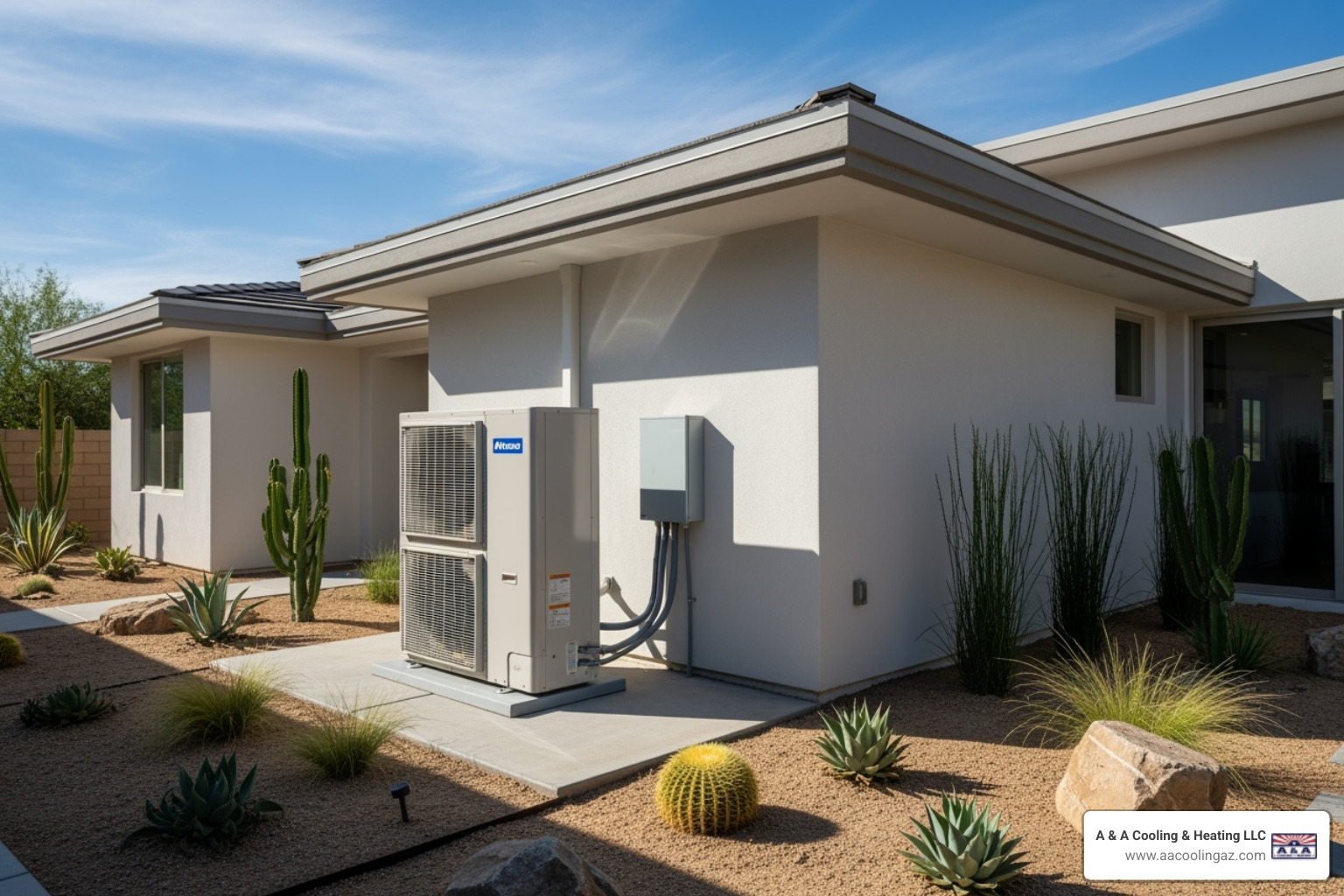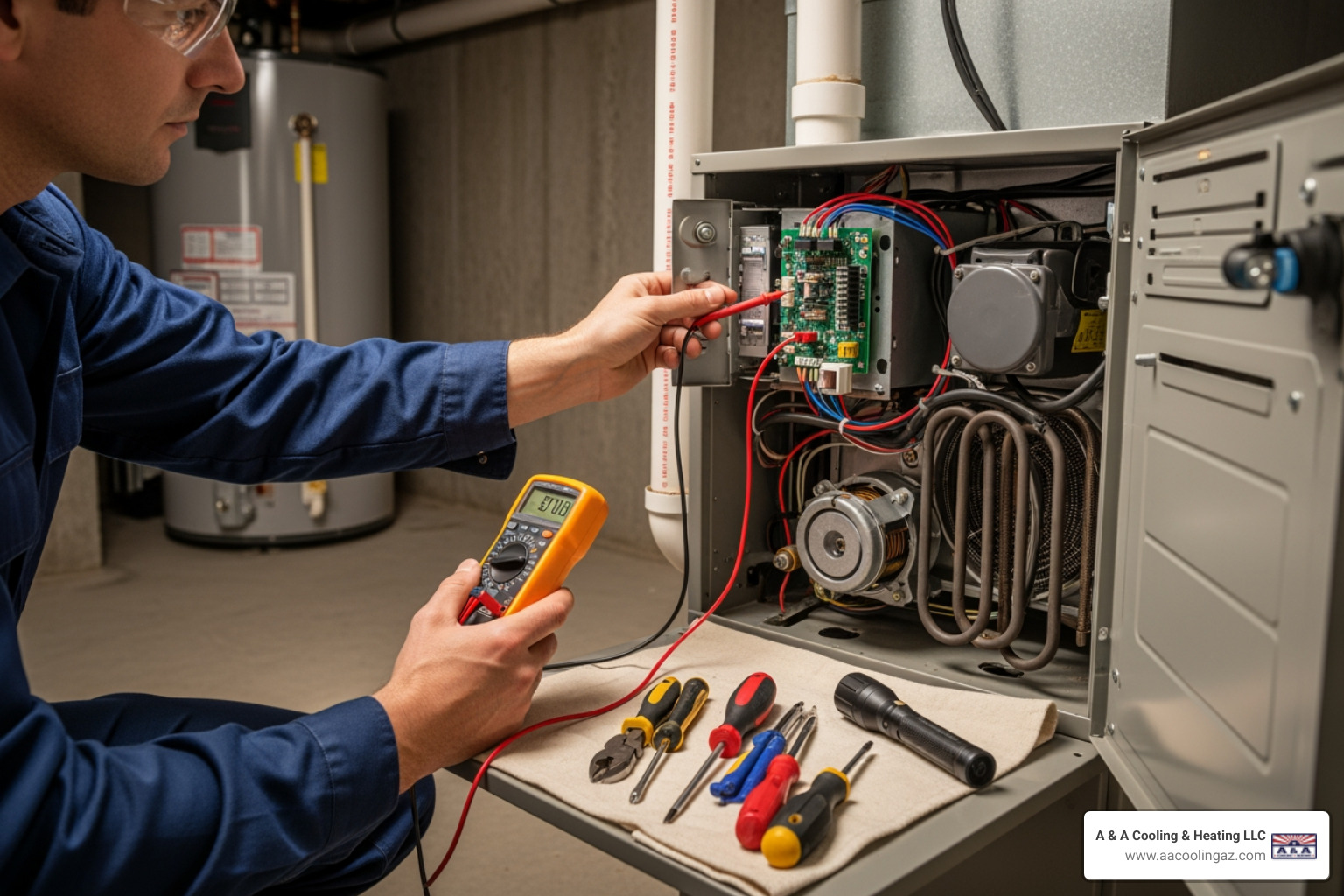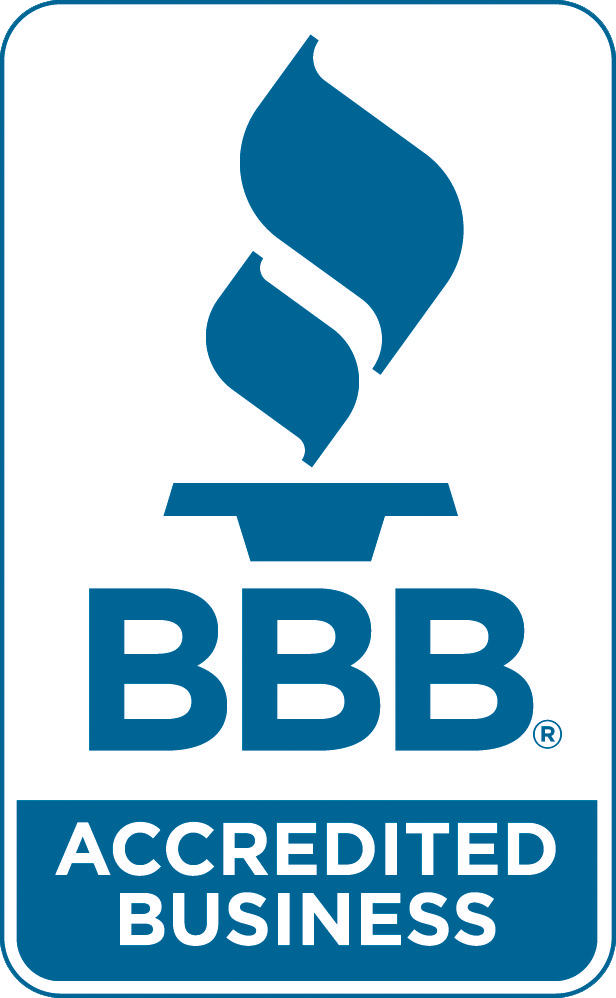Gilbert Heater Woes: What to Do When Your Furnace Fails

When Your Gilbert Heater Stops Working: Quick Action Steps
Heater not working gilbert situations can turn a comfortable desert home into an uncomfortable space faster than you'd expect. While Gilbert's winters are mild compared to northern states, those chilly desert nights still require a functioning heating system to keep your family comfortable.
Quick diagnosis steps for a non-working heater:
- Check thermostat settings - Ensure it's set to "heat" and temperature is above current room temp
- Verify power supply - Check circuit breakers and furnace power switch
- Inspect air filter - Replace if dirty or clogged (restricts airflow)
- Look for obvious signs - Strange noises, burning smells, or water pooling
- Test pilot light - Should burn blue, not yellow (gas furnaces only)
When your furnace fails in Gilbert, it creates more than just discomfort. Research shows that heating systems can provide 10-15 years of reliable service with proper maintenance, but Arizona's unique desert environment presents specific challenges. Dust, debris, and temperature fluctuations put extra strain on heating equipment.
The most common signs your Gilbert heater needs immediate attention include no heat production, blowing cold air, unusual noises like banging, and poor air quality. These symptoms often indicate issues ranging from simple filter problems to more complex mechanical failures.
Understanding what's wrong with your heating system helps you decide whether it's a simple DIY fix or requires professional intervention. Some problems - like gas smells or carbon monoxide detector alarms - demand immediate professional attention for safety reasons.
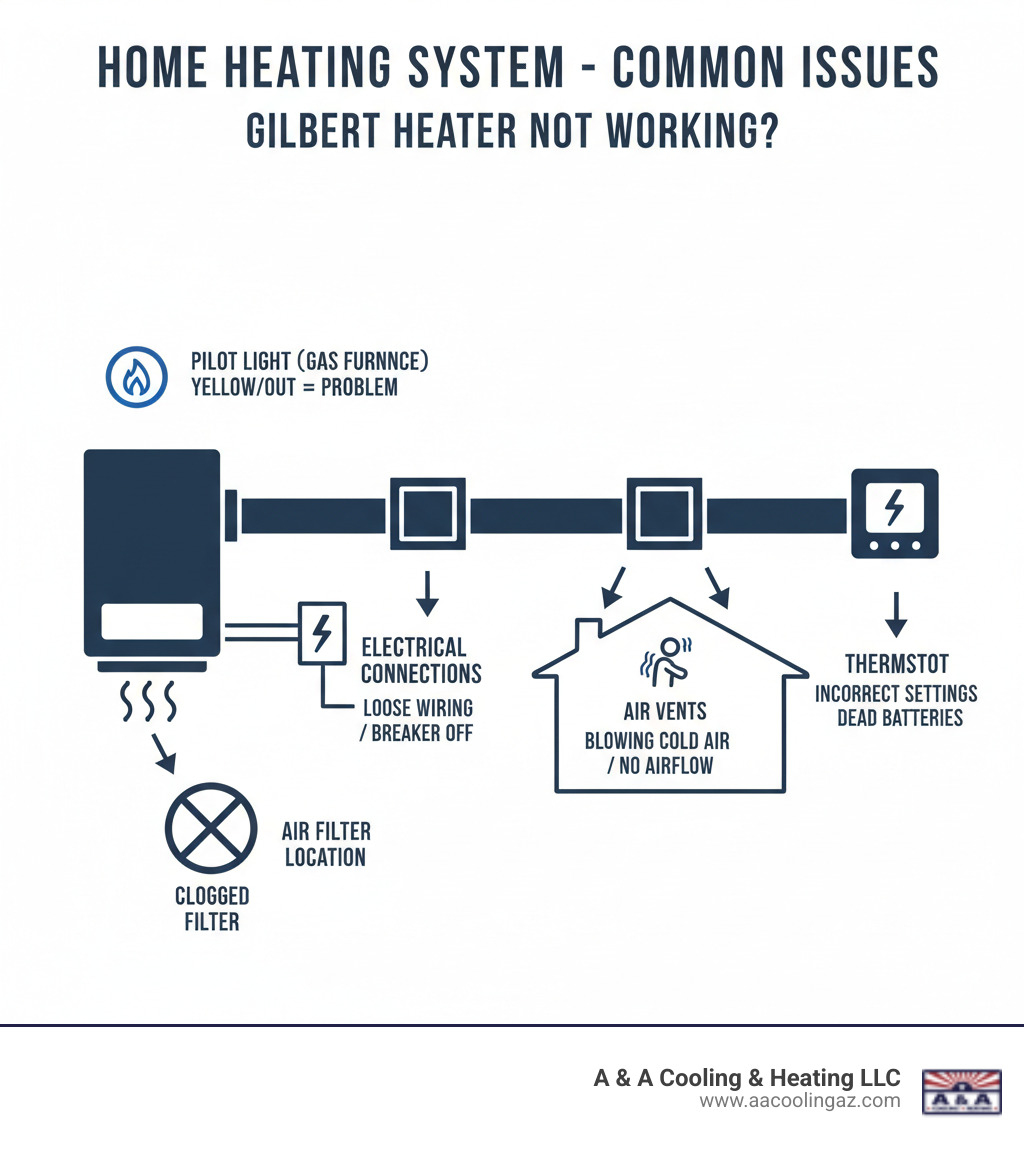
Telltale Signs Your Heater Needs Repair
Picture this: you're settling in for a cozy evening with your family, but when you adjust the thermostat, nothing happens. Or maybe your heater not working gilbert situation starts with strange sounds coming from your furnace room. These moments are never convenient, but catching the warning signs early can save you from a complete system breakdown during those surprisingly chilly desert nights.
The most obvious red flag is when your heater simply produces no heat at all. You hear the system running, but your home stays uncomfortably cold. Even worse is when your heating system starts blowing cold air through the vents - that's your heater's way of waving a white flag.
Uneven heating throughout your home tells a story too. When your living room feels like a sauna while your bedroom could store ice cream, your heating system is struggling to distribute warm air properly. This usually points to ductwork issues or a failing blower system.
Keep an eye on those increased energy bills as well. When your heating costs suddenly spike without explanation, your system is working overtime to maintain comfortable temperatures. This inefficiency often signals underlying problems that need attention before they get worse.
Don't ignore poor air quality either. If you notice more dust floating around, strange odors coming from your vents, or family members suddenly dealing with more allergies, your heating system might be circulating contaminants instead of clean, warm air.
For more detailed information about these warning signs, check out our comprehensive guide on Signs You Need Heating Repair.
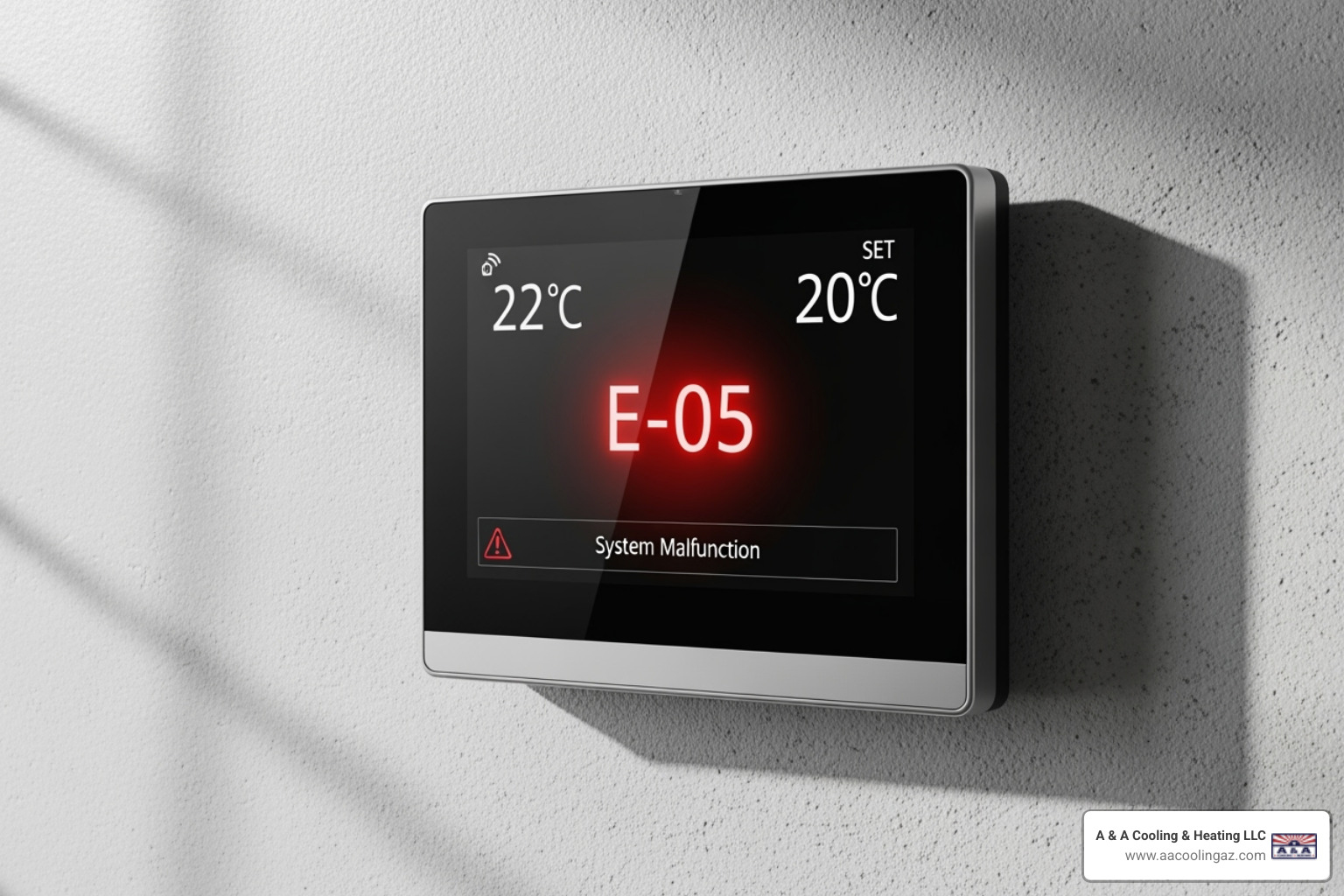
Key Indicators Your Heater is Not Working in Gilbert
Beyond the basic "no heat" problem, specific symptoms can help pinpoint exactly what's going wrong with your system. These details often lead our technicians straight to the root cause.
Strange noises from your heating system deserve immediate attention. We're not talking about the gentle whoosh of air moving through ducts - we mean banging sounds, grinding, squealing, or rattling. These sounds usually indicate loose components, worn bearings, or problems with the blower motor.
A burning odor coming from your vents raises immediate concerns. While a slight dusty smell when you first fire up your heater for the season is normal, persistent or strong burning smells could signal electrical problems, overheating components, or even a cracked heat exchanger.
Water pooling around your furnace never belongs there. This could indicate a blocked condensate drain, a leaking heat exchanger, or other internal problems. Water and heating systems don't mix well, and ignoring this issue can lead to serious damage.
For gas furnaces, watch your pilot light carefully. A healthy pilot light burns steady blue, but a yellow furnace flame indicates incomplete combustion. This creates dangerous carbon monoxide and requires immediate professional attention.
Frequent cycling - when your heater turns on and off repeatedly in short intervals - suggests your system can't maintain proper temperatures. This could stem from thermostat problems, clogged filters, or sizing issues with your equipment.
Our detailed article on Signs You Need Furnace Repair provides even more specific guidance on these warning signs and what they typically mean for your heating system.
Common Causes for a Heater Not Working in Gilbert

When your heater not working gilbert situation strikes, there's usually a reason behind the madness. After nearly five decades of fixing heating systems in the desert, we've seen the same culprits show up again and again. The good news? Many of these issues are more common than you might think, and some are surprisingly simple to prevent.
The number one offender we encounter is clogged air filters. Picture this: your heating system is like a marathon runner, and the air filter is its breathing apparatus. When that filter gets packed with Gilbert's desert dust, pet hair, and everyday household particles, your heater starts gasping for air. It has to work twice as hard to push warm air through your home, which drives up your energy bills and puts serious stress on the entire system.
Thermostat malfunctions are another frequent troublemaker. Your thermostat acts as the command center for your heating system, so when it goes haywire, everything else follows suit. Sometimes it's sending mixed signals to your furnace, other times it's not communicating at all. The result? You might get no heat, constant cycling, or rooms that feel like they're in different climate zones.
Power supply issues can also leave you in the cold. Your heater needs electricity to run its fans, ignition systems, and controls. When a circuit breaker trips, a fuse blows, or an internal power switch fails, your heating system becomes an expensive piece of yard art.
Finally, there's the reality of general wear and tear. Heating systems work hard, especially during Gilbert's chilly desert nights when temperatures can drop dramatically. Over time, moving parts wear out, electrical connections loosen, and components simply reach the end of their useful life. It's the natural aging process that affects all mechanical systems.
For a deeper dive into these issues and how they affect your comfort, check out our comprehensive guide on Common Heating Repair Issues.
Gas Furnace Problems
Gas furnaces have their own personality quirks, and understanding them can save you from some chilly nights and emergency repair calls.
Pilot light issues top the list of gas furnace complaints. When your pilot light won't stay lit or refuses to ignite, you're not getting heat. Sometimes the problem is as simple as a dirty pilot light – think of it like trying to light a candle with a wick covered in wax buildup. The flame just won't catch properly.
Thermocouple problems often go hand-in-hand with pilot light troubles. This little safety device acts like a vigilant guard, shutting off the gas supply if it doesn't sense a pilot flame. When it malfunctions, it might think the pilot is out even when it's burning bright, leaving you without heat as a "safety" measure.
Gas supply interruptions can also stop your furnace in its tracks. Whether it's a closed valve, meter issues, or problems with the gas line itself, no gas means no heat. If you suspect any gas-related problems, safety comes first – these situations require immediate professional attention.
Heat-control problems show up as inconsistent heating patterns. Your furnace might run too long, cycle too frequently, or struggle to reach the temperature you've set. Often, these issues stem from restricted airflow caused by dirty filters or blocked vents.
Our detailed article on Heating Repair Common Problems covers these gas furnace issues and more.
Electric Furnace & Heat Pump Issues
Electric heating systems march to the beat of a different drum, with their own set of potential hiccups that can leave you reaching for extra blankets.
Faulty wiring poses both a comfort and safety concern in electric furnaces. When wires become damaged, loose, or corroded, they can't deliver the power your heating elements need. This might show up as partial heating, no heating at all, or dangerous electrical hazards that require immediate attention.
Tripped breakers often signal that your electrical system is working overtime. While flipping a breaker back on might seem like a quick fix, breakers trip for a reason. If it keeps happening, there's likely an electrical overload or short circuit somewhere in your heating system that needs professional diagnosis.
The starting capacitor might be small, but it plays a huge role in getting your electric furnace up and running. When this component fails, your system might hum and strain but never actually start, or it might struggle to get the blower motor spinning. It's like trying to start a car with a weak battery – you hear the effort, but nothing happens.
Heat pump systems add another layer of complexity with their refrigerant leaks. Since heat pumps move heat rather than create it, they depend on proper refrigerant levels to transfer warmth from outside air into your home. When refrigerant leaks out, your heat pump loses its ability to heat effectively, and continued operation can damage the compressor.
Blower motor failure affects both electric furnaces and heat pumps. Even if your heating elements or coils are working perfectly, a failed blower motor means no air circulation. You might notice strange grinding or squealing sounds, or simply no airflow from your vents despite the system running.
For more insights into these and other common heating repairs, explore Common Heating Repair Issues.
Simple DIY Troubleshooting Steps to Try First
When you find your heater not working gilbert home situation, don't reach for the phone just yet! Before calling in the professionals, there are several straightforward checks you can perform yourself. These simple steps often solve the problem and might save you both time and money.
Let's start with the most common culprit: your thermostat settings. It sounds almost too basic, but you'd be surprised how often we get calls only to find the thermostat was accidentally switched to "cool" instead of "heat." Make sure it's set to "Heat" mode and that the temperature setting is actually higher than your current room temperature. Also check that the fan setting is on "Auto" rather than "On" - unless you specifically want air circulating continuously.
If your digital thermostat screen looks dim or isn't responding, the issue might be as simple as dead batteries. Pop in some fresh ones and see if that brings your system back to life. It's amazing how such a small thing can shut down your entire heating system!
Next, take a walk over to your furnace and look for the furnace power switch. This looks just like a regular light switch and is usually mounted on the unit itself or on a nearby wall. Someone might have accidentally flipped it off while doing laundry or storing items. Make sure it's in the "On" position.
Head to your electrical panel and check the circuit breaker that controls your heating system. If it's tripped, you'll see it sitting halfway between "On" and "Off." Flip it completely off first, then back on. However, if it trips again immediately, that signals an electrical problem that needs professional attention.
Don't forget about your air filter! Pull it out and take a look - if it's dark, dusty, or you can't see light through it, replace it right away. A clogged filter is like trying to breathe through a pillow; your system simply can't move air properly.
Finally, do a quick walk-through of your home to ensure all air vents are clear. Move any furniture, rugs, or curtains that might be blocking the airflow. Your heating system needs those pathways open to distribute warm air effectively throughout your house.
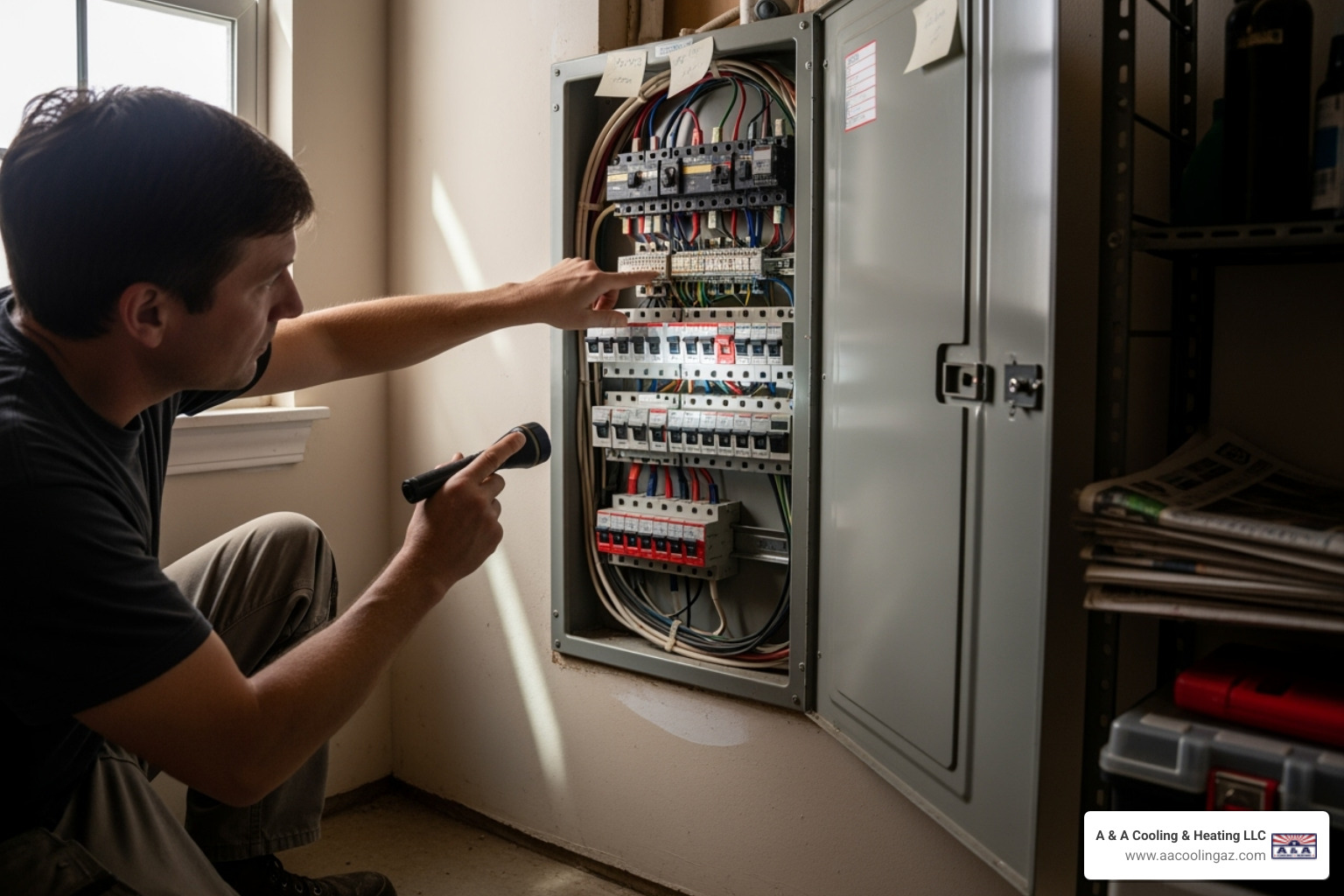
These basic troubleshooting steps resolve many heating issues we encounter. For more detailed guidance on these checks, visit our comprehensive Troubleshooting Tips for Heater Not Working guide. You might also find this helpful video tutorial: Furnace Won't Turn On? Here Are 5 Easy Things To Check - YouTube.
If you've tried all these steps and your heater still isn't cooperating, it's time to call in the experts. Some problems require professional tools, experience, and safety knowledge that go beyond basic homeowner maintenance.
When to Call a Professional for Heater Repair in Gilbert
Sometimes, despite your best troubleshooting efforts, your heater not working gilbert situation just won't resolve itself. That's when it's time to wave the white flag and bring in the cavalry. Trust me, there's no shame in calling for backup when dealing with complex heating systems – in fact, it's often the smartest move you can make.
If your DIY troubleshooting steps didn't get your heater humming again, that's your first clear signal that professional help is needed. Modern heating systems are intricate machines with dozens of moving parts, electrical connections, and safety mechanisms. What might seem like a simple fix can quickly turn into a costly mistake if you're not equipped with the right tools and knowledge.
When you're dealing with complex mechanical parts like blower motors, heat exchangers, or gas valves, it's definitely time to step back and let the pros take over. These components require specialized diagnostic equipment and years of experience to repair safely. The same goes for electrical problems – faulty wiring, blown capacitors, and circuit issues can be dangerous territory for DIY enthusiasts.
The bottom line? Your heating system is a significant investment in your home's comfort and safety. Protecting that investment means knowing when to call in experienced technicians who can diagnose the problem correctly the first time. For reliable service in your area, our Furnace Repair Gilbert, AZ team is ready to help get your home comfortable again.
Safety First: Red Flags When Your Heater is Not Working in Gilbert
Some heating problems go way beyond comfort issues – they can put you and your family in real danger. If you encounter any of these warning signs, don't hesitate for even a moment. Turn off your heating system immediately and get professional help right away.
The gas smell or rotten egg odor is the granddaddy of all red flags. Natural gas companies add that distinctive sulfur smell specifically so you'll notice it. If you catch even a whiff of that rotten egg scent, evacuate your home immediately. Don't flip any switches, don't light matches, and call your gas company from outside your home. This isn't being overly cautious – it's being smart.
When your carbon monoxide detector alarm goes off, treat it like the life-saving device it is. Carbon monoxide is invisible, odorless, and deadly. Even if you feel fine, get everyone out of the house and call for help. Your heating system might be producing this dangerous gas due to incomplete combustion or a cracked heat exchanger.
Loud, persistent mechanical noises that sound like your furnace is trying to escape from the basement deserve immediate attention. We're talking about grinding, screeching, or banging sounds that make you wince. These noises often signal major mechanical failure that could lead to complete system breakdown or even safety hazards.
For gas furnaces, keep an eye on that pilot light. A healthy flame burns steady and blue. If you see a yellow or flickering pilot light, that's your heating system's way of telling you something's wrong with the combustion process. This can lead to carbon monoxide production and needs professional assessment immediately.
Finally, scorch marks around the furnace are never, ever normal. Any signs of burning, charring, or discoloration around your heating system – especially near electrical components – indicate a serious fire hazard. This is an emergency situation that requires immediate professional intervention.
Choosing a Reputable Gilbert HVAC Company
When your heating system is on the fritz, you want to make sure you're putting your trust in the right hands. After all, you're inviting someone into your home to work on one of your most important systems. Here's what separates the pros from the pretenders.
First and foremost, make sure any company you're considering is licensed and insured. This isn't just paperwork – it's your protection. Licensed technicians have met state requirements and demonstrated their competency. Insurance protects you if something goes wrong during the repair. You can verify licenses through the Arizona Registrar of Contractors to make sure everything's legitimate.
Look for experienced technicians who've seen it all before. There's no substitute for hands-on experience when it comes to diagnosing tricky heating problems. Seasoned professionals can often spot issues that newer technicians might miss, potentially saving you time and money.
Positive customer reviews tell the real story about a company's service quality. Take a few minutes to read what other Gilbert homeowners have to say. Look for patterns in the feedback – do customers consistently mention prompt service, fair pricing, and quality work? A strong reputation in the community often reflects years of reliable service and customer satisfaction.
Pay attention to how potential service providers communicate with you. Good HVAC companies explain problems clearly, answer your questions patiently, and never pressure you into unnecessary repairs. They should make you feel informed and comfortable with the proposed solution, not confused or rushed into a decision.
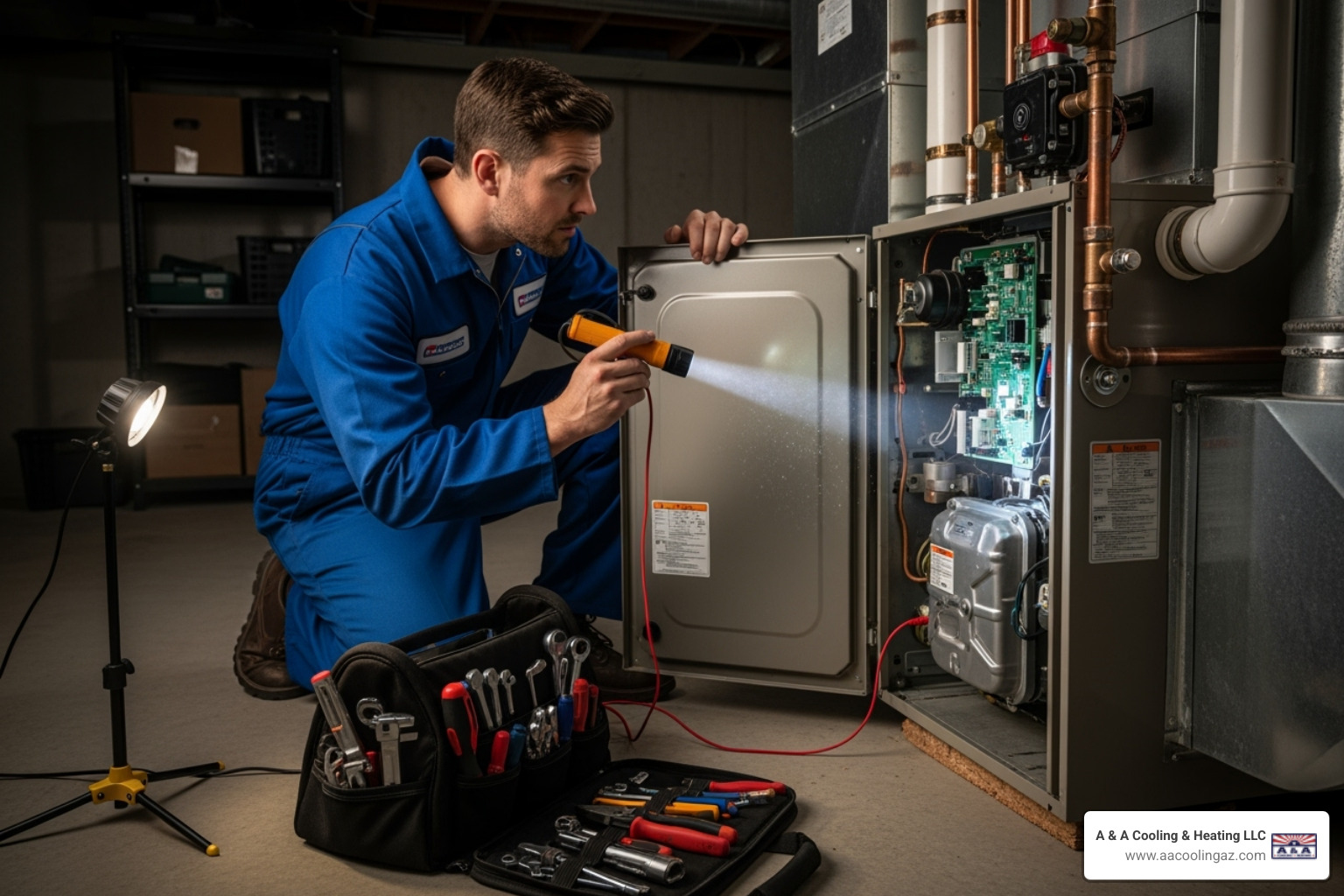
The Importance of Regular Maintenance in the Gilbert Climate
Living in Gilbert means enjoying beautiful desert weather most of the year, but it also means your heating system faces unique challenges that many other climates don't experience. While your heater might not run as frequently as those in colder states, the Gilbert climate impact on your HVAC system is significant and requires special attention.
The desert brings one major enemy to your heating system: dust and debris. That fine, powdery dust that seems to settle on everything in your home? It's doing the same thing inside your furnace. This persistent dust infiltrates your system, clogging filters faster than you might expect, coating coils, and gumming up moving parts. Without regular attention, this buildup creates a domino effect of problems that can leave you with a heater not working gilbert situation right when you need it most.
Think of regular maintenance as an investment in your comfort and wallet. A well-maintained heating system can provide 10-15 years of reliable service, sometimes even longer. Just like your car needs regular oil changes to keep running smoothly, your heater needs periodic tune-ups to perform at its best. The difference between a maintained and neglected system often means the difference between a minor adjustment and a major repair bill.
Energy efficiency is another compelling reason to stay on top of maintenance. When your system is clean and properly calibrated, it doesn't have to work as hard to heat your home. Clean filters allow proper airflow, calibrated thermostats prevent unnecessary cycling, and well-lubricated parts reduce friction and energy waste. All of this translates to lower utility bills – money that stays in your pocket instead of going to the electric company.
Safety should never be taken lightly, especially with gas heating systems. Regular maintenance includes crucial safety checks like inspecting the heat exchanger for cracks, ensuring proper combustion, and verifying that carbon monoxide isn't leaking into your home. For all heating systems, maintenance includes checking electrical connections and ensuring components aren't overheating, reducing fire risks significantly.
Don't overlook the better air quality benefits of regular maintenance. Clean filters mean fewer allergens, dust particles, and pollutants circulating through your living space. This is especially important in Gilbert's dusty environment, where outdoor air quality can impact what's happening inside your home. Your family breathes easier when your system is clean and functioning properly.
For more insights into why these routine checks matter so much, check out our detailed guides on Why Regular HVAC Service is Important and Why Furnace Maintenance is Crucial. A little preventive care now can save you from those middle-of-the-night emergency calls when your heater decides to take an unscheduled break.
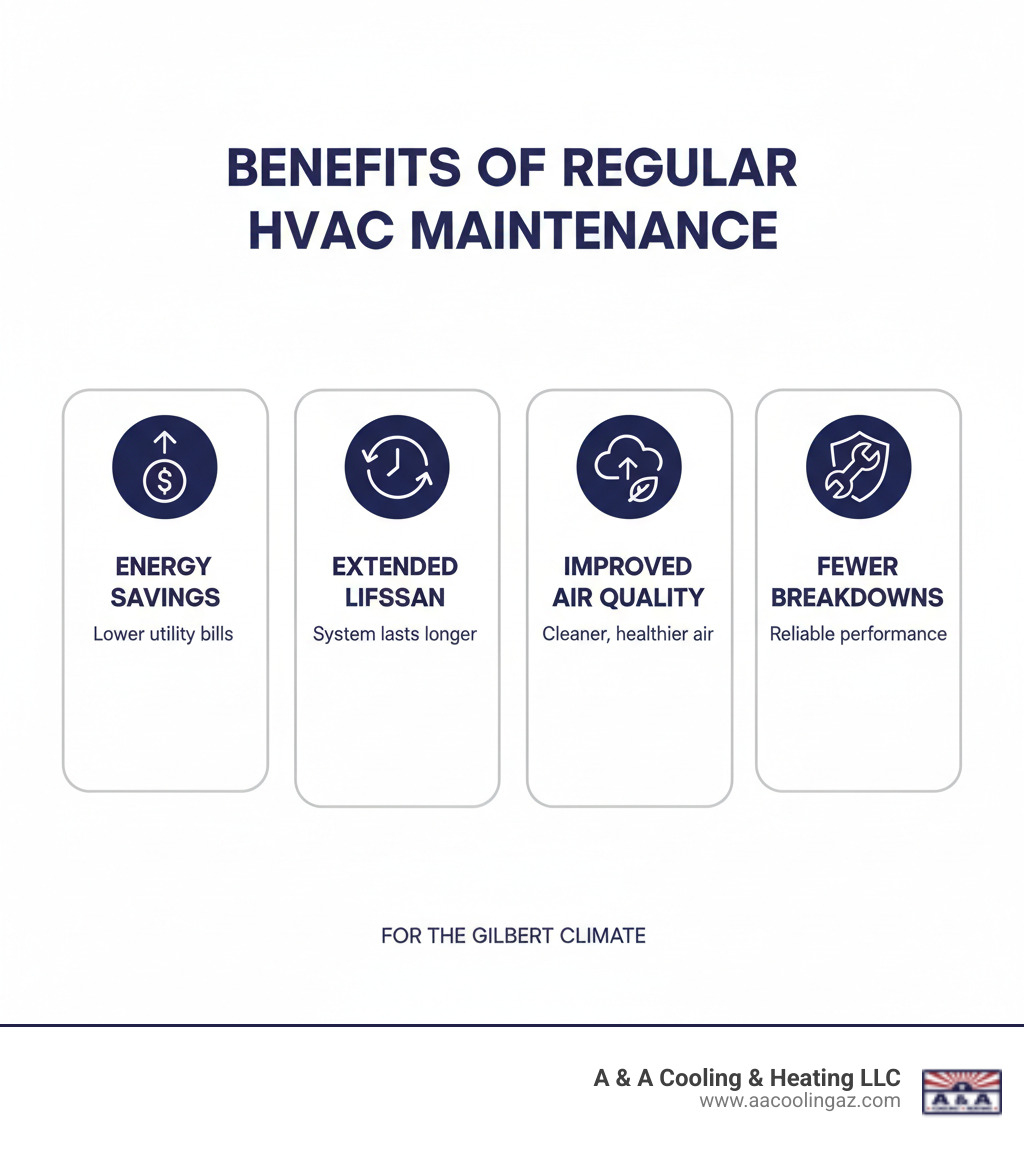
Conclusion
When you're dealing with a heater not working gilbert situation, you're not powerless. We've given you a roadmap to tackle these chilly challenges with confidence, and now you have the tools to turn your desert home back into the cozy sanctuary it should be.
Start by recognizing those telltale signs - whether it's your heater blowing cold air, making strange banging noises, or sending your energy bills through the roof. These warning signals are your heating system's way of asking for help, and catching them early can save you from bigger headaches down the road.
Don't overlook the power of simple DIY troubleshooting. Sometimes the solution is as easy as flipping a switch, replacing batteries in your thermostat, or swapping out a dirty air filter. These quick fixes might seem too simple to work, but you'd be surprised how often they solve the problem completely.
However, never compromise on safety. If you smell gas, hear your carbon monoxide detector, or notice scorch marks around your furnace, don't try to be a hero. Turn off your system immediately and call for professional help. Some problems are simply too dangerous to handle on your own.
When those DIY steps don't do the trick, or when you're facing complex mechanical or electrical issues, it's time to bring in the experts. That's where we come in. A & A Cooling & Heating LLC has been keeping Gilbert families comfortable since 1976, and we understand exactly what your heating system needs to perform its best in our unique desert climate.
The secret to avoiding future heater not working gilbert emergencies lies in prevention. Our Cool Club maintenance plan helps you stay ahead of problems before they leave you shivering on a cold desert night. Regular maintenance isn't just about fixing things when they break - it's about keeping your system running efficiently, safely, and reliably for years to come.
Don't wait until the next cold snap catches you off guard. Take action now to ensure your heating system is ready when you need it most. Schedule your professional HVAC services today and let our experienced team bring warmth, comfort, and peace of mind back to your Gilbert home.






